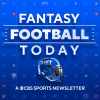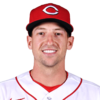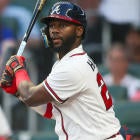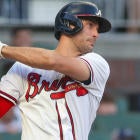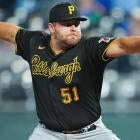
We now know that the return of position scarcity was a one-year blip brought about by an outlier 2022 season. My early look at the infield positions showed each to be well stocked, with most featuring stretches of six or seven players so similar that they're near impossible to rank.
It would be natural, then, to presume that outfield is much the same way. Sadly, that's not the case.
OK, so it's not terrible. In fact, no other position is deeper in early-round talent. But once you get past that early-round talent, you're met with glaring flaws and uncertainty. And it's not long after that that you arrive at the outfielders who are decidedly less than studly.
Overall, I'd still say it's in a better spot than it was at this point last year. But if you're going to prioritize any position in the name of scarcity, outfield is the early favorite.
For what it's worth, Marcell Ozuna and Eloy Jimenez weren't up for consideration here. Both will be DH-only to begin 2024.
Note that the focus here is standard 5x5 scoring (such as Rotisserie leagues), but scroll a little further and you'll see my rankings for points leagues.
| 1 |
Ronald Acuna
Atlanta Braves RF
|
| Coming off the first ever 40-homer, 70-steal season - one that also saw Acuna score the second-most runs (149) for any player since 1949 while sustaining a batting average (.337) that would have led the majors three of the past five years -- there can be no easier ranking than this. | |
| 2 |
Julio Rodriguez
Seattle Mariners CF
|
| The peaks and valleys can be pretty intense for Rodriguez, who went from hitting in the .210s for most of May to approaching .290 in September only to finish at .275. But in the end, he had a combined 69 home runs and stolen bases and made enough of a leap in Year 2 to suggest a 40/40 outcome is on the table for Year 3. | |
| 3 |
Corbin Carroll
Arizona Diamondbacks LF
|
| If your biggest goal in Round 1 is to pile on stolen bases, then there's certainly a case for taking Carroll, who had 54 of them as a rookie, ahead of Julio Rodriguez , especially since he might also be the better bet for batting average. Twice midseason we thought his season had ended because of a shoulder injury, though, and it's still unclear what exactly happened with that. | |
| 4 |
Mookie Betts
Los Angeles Dodgers RF
|
| Part of me wants to rank Betts second here, particularly given his dual eligibility at second base. But the kind of stolen base totals the three ahead of him are capable of delivering is simply too massive to pass up, even with everything else Betts brings to the table. | |
| 5 |
Kyle Tucker
Houston Astros RF
|
| Tucker came within a home run of his first ever 30/30 season, and his stolen bases continue to increase even as his sprint speed dips into the blue. He also saw his batting average rebound, which seemed likely given his low strikeout rate, so at this point, there's little reason to doubt him as a five-category standout. | |
| 6 |
Fernando Tatis
San Diego Padres RF
|
| Between the shoulder surgery, the wrist surgery and the PED suspension that cost Tatis all of 2022, perhaps we should have known better than to expect his very best in 2023, and yet he still delivered a 25-homer, 25-steal season. The biggest disappointment was the batting average, which cratered in the second half, but his .282 xBA suggests the outlook is still sunny there. | |
| 7 |
Aaron Judge
New York Yankees RF
|
| Tatis and Judge are the two who may be getting short shrift here, both possessing the upside to be the No. 1 player in Fantasy and both having valid excuses for "disappointing" in 2023. Judge was on a 51-homer pace when he tore his toe ligament in early June, and his Statcast readings are near identical to his 62-homer 2022. He's no stranger to injury, though. | |
| 8 |
Yordan Alvarez
Houston Astros DH
|
| A left-handed hitter, Alvarez is basically Judge's mirror image in power-hitting perfection but also suffers from the same affliction. Their big bodies break down too easily. If he manages to stay healthy, it's not unthinkable Alvarez could compete for both a batting title and a home run title, which puts him in the discussion for best at this position as well. | |
| 9 |
Juan Soto
San Diego Padres LF
|
| With a year-and-a-half sample now, it certainly seems like San Diego may be suppressing Soto's numbers a bit, and if we're not certain he can deliver a .300 batting average, he probably doesn't belong in Round 1. That changes in points leagues, of course, given that his plate discipline remains second to none. | |
| 10 |
Mike Trout
Los Angeles Angels CF
|
| Everything is trending the wrong direction for Trout, who's no longer a batting average standout due to an escalating whiff rate and is far removed from being a base-stealer. He's still pretty studly when healthy, but only pretty studly -- and rarely healthy, having averaged 79 games over the past three years. | |
| 11 |
Luis Robert
Chicago White Sox CF
|
| Robert finally managed to deliver the healthy season we dreamed of since he first arrived in 2020, and it basically lived up to the hype with him approaching 60 combined home runs and stolen bases. Unfortunately, he was the lone bright spot on a White Sox team looking to tear everything down, so even if he manages to repeat the feat, his runs and RBI may disappoint. | |
| 12 |
Cody Bellinger
Chicago Cubs CF
|
| Also draftable at first base, Bellinger is needed more at this position, but sadly, the greater need doesn't bring further assurances. His return to MVP-caliber production was perplexing because it came after three miserable seasons and wasn't fully backed up by the Statcast data, particularly the exit velocities. Adding to the confusion is that he'll hit the open market this offseason. | |
| 13 |
Adolis Garcia
Texas Rangers RF
|
| After another year of him proving the doubters wrong, it's probably time to stop doubting Garcia, who has all the characteristics of an elite power hitter. Then again, he seemed to give up on stealing bases this year and remains a liability for batting average, but his run and RBI production in the Rangers lineup should make up for it. | |
| 14 |
Kyle Schwarber
Philadelphia Phillies LF
|
| Schwarber followed up a 46-homer season with a 47-homer season, ranking second in baseball both times, but his batting average continued to sag to .197. It's such an extreme profile for 5x5 scoring that he simply may not be viable for some builds. Since he walks enough to stay at the top of the Phillies lineup, you can at least trust the runs and RBI to be there. | |
| 15 |
Michael Harris
Atlanta Braves CF
|
| Harris' 2023 corroborated his breakthrough 2022 in particularly dramatic fashion, seeing him overcome a miserable start to hit .335 with 16 homers, 15 steals and a .912 OPS over his final 100 games. You'd think it would put him in the top 10 for next year, but he can't seem to climb out of the ninth spot in a loaded Braves lineup, which kills him in runs and RBI. | |
| 16 |
Randy Arozarena
Tampa Bay Rays LF
|
| Arozarena seemed to find another gear in the first half, but a bumpy finish brought his numbers back down to size and more in line with where Statcast said they should be all along. Seeing as he also stopped running as much in a year when the rest of the league ran all the more, there's some danger in overvaluing him. | |
| 17 |
Christian Yelich
Milwaukee Brewers LF
|
| After three years of falling short of expectations, Yelich finally managed to exceed them in 2023, mostly by taking advantage of the friendlier stolen base environment. His batting average and home runs were up as well -- more subtly, but enough that this ranking depends on its continuance. His late-season back issues are a reminder why it may not. | |
| 18 |
Nolan Jones
Colorado Rockies LF
|
| If you tuned out once Fantasy Football started, this ranking may surprise you, but Jones had seven homers and 12 steals in September to make him a 20/20 man in just 106 games. He's plenty tooled up with high exit velocities and sprint speed, and the Coors Field BABIP bump helps to mask his high strikeout rate. | |
| 19 |
Joshua Lowe
Tampa Bay Rays RF
|
| It's tempting to rank Lowe higher than this given that he had more combined home runs and stolen bases, not to mention a much higher batting average, than Randy Arozarena , and a deeper dive into the data doesn't reveal any major red flags. The Rays seemed reluctant to play him against left-handers, though, and seeing as that's their M.O., you can't presume it'll change. | |
| 20 |
Jazz Chisholm
Miami Marlins CF
|
| We could again pretend that Chisholm's 162-game pace (31 homers and 36 steals, if you're keeping score at home) means something, or we can acknowledge that he'll probably come nowhere close to playing 162 games, having suited up for only 55 percent of his team's games across four seasons. Still, there's always a chance. | |
| 21 |
Bryan Reynolds
Pittsburgh Pirates LF
|
| Reynolds kicks off a more boring stretch of the outfield rankings. It's fair to assume, particularly now that he's locked up with the Pirates , that nobody is eager to draft him even though he's plainly must-start. He deserved a better batting average than he got, though, and could prove to be a value if he brings it up near .300 again. | |
| 22 |
George Springer
Toronto Blue Jays RF
|
| Perhaps this is too sunny of an outlook for Springer, whose career-worst .405 slugging percentage hints of real decline even though he managed to eke out his first ever 20/20 season. The issue may have simply been that he wasn't pulling the ball as much early on, and his track record has earned him some benefit of the doubt. | |
| 23 |
Evan Carter
Texas Rangers LF
|
| It's hard to say both where Carter should go given the small sample of production and where he will go given the mounting enthusiasm for him, but clearly, there's a lot to like. He showed in his late-season call-up a knack for getting on base, a willingness to run and a better power profile than the raw data would suggest. | |
| 24 |
Spencer Steer
Cincinnati Reds 1B
|
| Steer was my No. 12 first baseman and No. 11 third baseman, so him ranking 24th at a position that's three times as big shows the relative shortcomings of the outfield. I have my doubts about his ability to live up to his surprising rookie season -- both because of his modest tools and the increasing competition on the Reds roster -- but Steer's triple eligibility is hard to pass up. | |
| 25 |
Seiya Suzuki
Chicago Cubs RF
|
| Suzuki's sophomore season was unfolding about as underwhelmingly as his rookie season until the calendar flipped to August and he went on to hit .350 with 12 homers and a 1.073 OPS in his final 50 games. Clearly, he's not that good, but this ranking trusts it was more than a blip for a player who may have needed some time to adjust to a new league. | |
| 26 |
Chas McCormick
Houston Astros LF
|
| McCormick was the surprise breakthrough of 2023, shining in a way that wasn't thought possible for a 28-year-old with mediocre numbers the previous two years. Manager Dusty Baker was a little funny about his playing time down the stretch and into the postseason, but there's no ignoring that he hit .290 with 18 homers, 15 steals and an .877 OPS over his final 90 games. | |
| 27 |
Lane Thomas
Washington Nationals RF
|
| Getting a chance to play more for a rebuilding club, Thomas delivered 28 homers and 20 steals, which placed him among the top 12 outfielders for both points and Rotisserie leagues. The profile doesn't support a high batting average, though, and he went on to hit .223 in the second half. Seems kind of flimsy overall. | |
| 28 |
Nick Castellanos
Philadelphia Phillies RF
|
| The postseason standout wasn't so bad during the regular season either, rebounding from a miserable first season with the Phillies to deliver 29 homers and 106 RBI. Half of those home runs came in the final two months, when Castellanos seemed committed to wearing out left field, though that pull-heavy approach will prevent him from hitting for the batting averages he once did. | |
| 29 |
Jorge Soler
Miami Marlins DH
|
| Though he could opt to remain with the Marlins , Soler seems more likely to test the market after turning in what was clearly his second-best season. We know at his best, the 31-year-old can slug with the best of them, but his career has been defined by injury and inconsistency, which makes him a risky pick even in this range | |
| 30 |
Jordan Walker
St. Louis Cardinals RF
|
| You could make the case for several others in this spot -- with Cedric Mullins , Anthony Santander and Ian Happ being the most notable among them -- but I think we've reached the point where it's reasonable to roll the dice on upside. While Walker's rookie season was a bust overall, he hit .277 with 14 homers and an .802 OPS after a minor-league stint and could make a big leap. | |
What changes in points leagues?
1. Ronald Acuña, ATL
2. Mookie Betts, LAD
3. Aaron Judge, NYY
4. Yordan Alvarez, HOU
5. Kyle Tucker, HOU
6. Corbin Carroll, ARI
7. Julio Rodriguez, SEA
8. Juan Soto, SD
9. Fernando Tatis, SD
10. Mike Trout, LAA
11. Cody Bellinger, FA
12. Kyle Schwarber, PHI
13. Christian Yelich, MIL
14. Luis Robert, CHW
15. Adolis Garcia, TEX
16. Michael Harris, ATL
17. Randy Arozarena, TB
18. Nolan Jones, COL
19. Bryan Reynolds, PIT
20. George Springer, TOR
21. Joshua Lowe, TB
22. Evan Carter, TEX
23. Jazz Chisholm, MIA
24. Spencer Steer, CIN
25. Seiya Suzuki, CHC
26. Nick Castellanos, PHI
27. Chas McCormick, HOU
28. Lane Thomas, WAS
29. Brandon Nimmo, NYM
30. Jorge Soler, MIA



